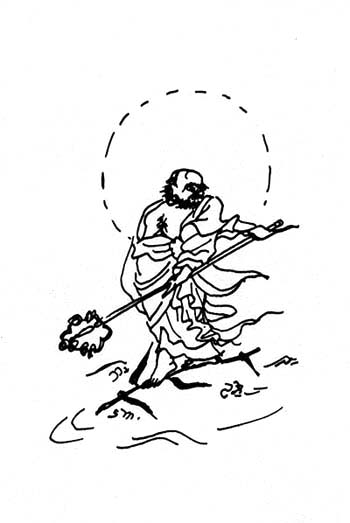|
||
 |
||

@
(C)2001 Japanese Architecture and Art Net Users System.@No reproduction or republication without written permission.
fÚÌeLXgEÊ^ECXgÈÇASÄÌRec̳f¡»E]ÚðֶܷB
|
||||||
| @ | ||||||
| Daruma@B | ||||||
| KEY WORD :@art history / iconography | ||||||
| @ | ||||||
| Sk: Bodhidharma. Ch: Damo. A semi-legendary Indian monk credited with bringing the teachings of Zen (Ch: Chan) to China. Much of what is known of Bodhidharma's biography is found in the 1053 DENPOU SHOUSHUUKI `@³@L (Ch: Chuanfa Zhengzongji ; A Record of the Transmission of the Law and Correct Teaching). The son of a Brahmin king in southern India, he achieved enlightenment as the 28th successor to Sakyamuni *Shaka ßÞ. Bodhidharma travelled by boat to Guangdong (Jp: Kanton L) around 520, and then made his way north to Nanjing (Jp: Nankin ì). There he met the Emperor Wu (Jp: Bu ; 502-550), founder of the Liang dynasty and a devout Buddhist, who is supposed to have asked: "What is the first principle of holy teaching?" Bodhidharma's enigmatic reply, which can be translated as there is no knowing, and vast emptiness, left the emperor baffled. Bodhidharma then crossed the Yangzi River (Jp: Yousukou kq]) and entered the Wei kingdom where he established himself at the Shaolin Temple (Jp: Shourinji Ñ) on Mt Song (Jp: Suuzan R). At the monastery Bodhidharma is said to have practiced seated meditation, zazen ¿T for nine years facing a cave wall. Eventually he took Huike (Jp: Eka dÂ; 487-593) to be his disciple. Bodhidharma was frequently rendered by both Chinese and Japanese painters of Zen subjects. The style of Bodhidharma paintings varies greatly, ranging from relatively descriptive patriarch portraits *chinsou ¸ in ink and color, to barely recognizable pictures done with a single stroke of ink Ippitsu Daruma êMB. The great number of Bodhidharma portraits stems from the fact that they were given to Zen disciples and hung as images of devotion in reminder of the continuous and true transmission of the Buddhist Law (Dharma). Bodhidharma is usually depicted with a large nose, bushy eyebrows, curly hair and beard, and wearing large earrings. According to some legends, Bodhidharma, impatient at having fallen asleep while meditating, cut off his eyelids. Artists often show him with large, staring eyes without eyelids. There are several basic types of Bodhidharma portraits. Most frequent are three-quarter depictions yokomuki ¡ü which include only Bodhidharma's craggy visage and the sweeping shoulder contour of his robe, bust portrait or hanshinzou ¼g, and frontal portraits shoumen ³Ê which show Bodhidharma wrapped in his priest's robe sitting in meditation. In addition to imaginary portraits, there are painting subjects derived from incidents in Bodhidharma's life. For instance, his crossing of the Yangtze, probably in a reed boat came to be depicted as the image of Bodhidharma standing or floating along on reeds, Royou Daruma °tB. Bodhidharma's years of meditation are represented with images of a seated monk facing a cave-wall called Wall gazing, Menpeki Daruma ÊÇB. Related are depictions of the disciple Huike presenting his cut-off arm *Eka Danpi dÂfä] as a sign of his serious desire to study meditation with the Indian master. The One Shoe Bodhidharma, Sekiri Daruma ÇB paintings feature Bodhidharma holding a single shoe and derive from the legend that Bodhidharma, after his death and burial on Mt Xioger (Jp: Yuujizan F¨R), came to life again and traveled back to India. A Chinese official returning from India reported he saw Bodhidharma in the mountains carrying a single sandal in his hand. When officials rushed to open Bodhidharma's tomb they found only the remaining sandal in the otherwise empty grave. Bodhidharma was also the subject of parody by *ukiyo-e ¢G artists who often showed him accompanied by courtesans. Bodhidarma is popularly represented in the bright red legless dolls developed in the 16c and commonly used in the Edo period as a charm against smallpox. | ||||||
| @ | ||||||
 |
||||||
@ |
||||||
| REFERENCES: | ||||||
| @ | ||||||
| EXTERNAL LINKS: | ||||||
| @@ | ||||||
| NOTES: | ||||||
| @ | ||||||
(C)2001 Japanese Architecture and Art Net Users System.@No reproduction or republication without written permission. fÚÌeLXgEÊ^ECXgÈÇASÄÌRec̳f¡»E]ÚðֶܷB |
||||||
| @ |